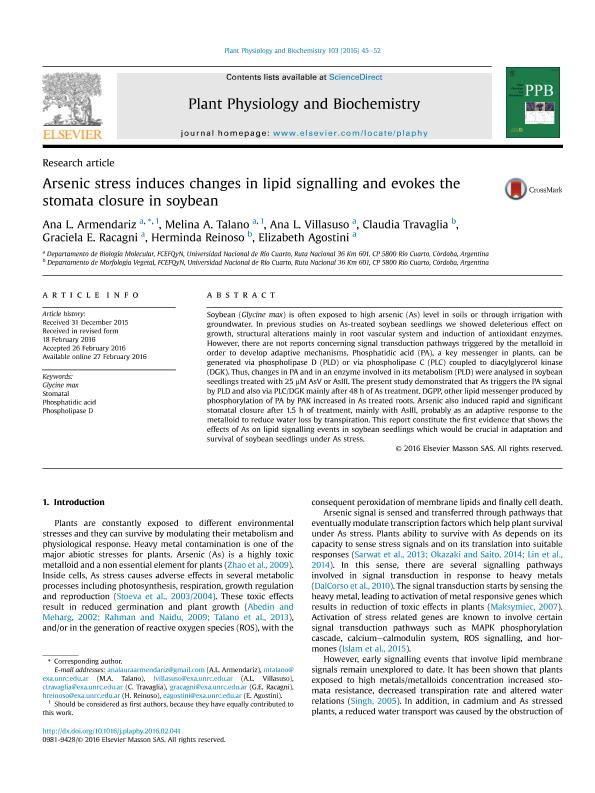Artículo
Arsenic stress induces changes in lipid signalling and evokes the stomata closure in soybean
Armendariz, Ana Laura ; Talano, Melina Andrea
; Talano, Melina Andrea ; Villasuso, Ana Laura
; Villasuso, Ana Laura ; Travaglia, Claudia Noemi
; Travaglia, Claudia Noemi ; Racagni, Graciela Esther; Reinoso, Herminda Elmira; Agostini, Elizabeth
; Racagni, Graciela Esther; Reinoso, Herminda Elmira; Agostini, Elizabeth
 ; Talano, Melina Andrea
; Talano, Melina Andrea ; Villasuso, Ana Laura
; Villasuso, Ana Laura ; Travaglia, Claudia Noemi
; Travaglia, Claudia Noemi ; Racagni, Graciela Esther; Reinoso, Herminda Elmira; Agostini, Elizabeth
; Racagni, Graciela Esther; Reinoso, Herminda Elmira; Agostini, Elizabeth
Fecha de publicación:
06/2016
Editorial:
Elsevier France-Editions Scientifiques Medicales Elsevier
Revista:
Plant Physiology and Biochemistry
ISSN:
0981-9428
Idioma:
Inglés
Tipo de recurso:
Artículo publicado
Clasificación temática:
Resumen
Soybean (Glycine max) is often exposed to high arsenic (As) level in soils or through irrigation with groundwater. In previous studies on As-treated soybean seedlings we showed deleterious effect on growth, structural alterations mainly in root vascular system and induction of antioxidant enzymes. However, there are not reports concerning signal transduction pathways triggered by the metalloid in order to develop adaptive mechanisms. Phosphatidic acid (PA), a key messenger in plants, can be generated via phospholipase D (PLD) or via phospholipase C (PLC) coupled to diacylglycerol kinase (DGK). Thus, changes in PA and in an enzyme involved in its metabolism (PLD) were analysed in soybean seedlings treated with 25 μM AsV or AsIII. The present study demonstrated that As triggers the PA signal by PLD and also via PLC/DGK mainly after 48 h of As treatment. DGPP, other lipid messenger produced by phosphorylation of PA by PAK increased in As treated roots. Arsenic also induced rapid and significant stomatal closure after 1.5 h of treatment, mainly with AsIII, probably as an adaptive response to the metalloid to reduce water loss by transpiration. This report constitute the first evidence that shows the effects of As on lipid signalling events in soybean seedlings which would be crucial in adaptation and survival of soybean seedlings under As stress.
Palabras clave:
GLYCINE MAX
,
PHOSPHATIDIC ACID
,
PHOSPHOLIPASE D
,
STOMATAL
Archivos asociados
Licencia
Identificadores
Colecciones
Articulos(CCT - CORDOBA)
Articulos de CTRO.CIENTIFICO TECNOL.CONICET - CORDOBA
Articulos de CTRO.CIENTIFICO TECNOL.CONICET - CORDOBA
Citación
Armendariz, Ana Laura; Talano, Melina Andrea; Villasuso, Ana Laura; Travaglia, Claudia Noemi; Racagni, Graciela Esther; et al.; Arsenic stress induces changes in lipid signalling and evokes the stomata closure in soybean; Elsevier France-Editions Scientifiques Medicales Elsevier; Plant Physiology and Biochemistry; 103; 6-2016; 45-52
Compartir
Altmétricas



